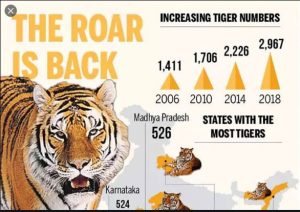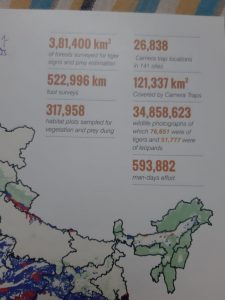
By Abhilash Khandekar*
(The second of two-piece special articles on the International Tiger Day, July 29, 2020)
India has approximately 2,967 tigers (range 2603-3346) in its wilds and that is a ‘big number’ considering the continuous heavy anthropogenic pressures on their habitats across the country. The British-ruled, undivided India, indeed, had many more tigers (Panthera tigris) when the then Rajas and Maharajas from various princely families used to hunt them at will.
That, however, is a glorious (sic) past. Jungles then were dense, the human population was less, the cities were not expanding at breakneck speed the way they do now, illicit wildlife trade was not heard of and thus forests abounded with wildlife, especially tigers, until a century ago. There were no strict wildlife laws restricting the hunting of tigers.
Despite the fact that shikar was a big sport, India had thousands of tigers roaming around in its jungles in the pre-Independence era. Some royal families, such as Dungarpur, Rajasthan, used to keep tally of ‘their’ tigers in their own way but not others, wildlife historian and expert Dr. MK Ranjitsinh, informs.

So counting of tigers has come a long way from a sketchy record, with no backing of science or technology, to the present system of the four-year rigorous cycle of counting each individual tiger. While the population of big cats is now believed to be going up, it can be seen as a ‘relatively’ big number under the present set of circumstances. It is mainly due to the modern conservation methods adopted by various states and the National Tiger Conservation Authority (NTCA) that the latest estimation shows some satisfactory growth. Otherwise, as per the International Union for Conservation of Nature (IUCN), the tiger continues to be a threatened species that needs all-round efforts for protection. For protection, we need to know if their population is increasing, stable, or going down.
It would be very interesting to know how the fearsome tigers are counted in modern times because it is an unimaginably mammoth task by any standards. Full of excitement and hard work!
Counting big cats is a complex technical exercise and requires huge trained manpower working in a vast area for a long time. It is jointly done by Wildlife Institute of India (WII), the NTCA, the states’ forest departments, and some dedicated NGOs. Obviously, it cannot be done in a day or a week or a month. The exercise is spread over several months and in different seasons and varied landscapes.

Curiously, an ordinary person cannot tell one tiger from another, not to speak of differentiating between a male and a female or a sub-adult and a fully-grown tiger. There are also many other challenges in this kind of physical counting. First and foremost, tigers walk a long distance within or even outside the territory of their own abodes. Secondly, the striped animals look quite alike and it is tough to distinguish one from another. Also, the rare and elusive species inhabits a wide variety of habitats such as high mountains, mangrove swamps, tall grasslands, dry and deciduous forests, and also the shola forest systems of South India.
India had, in the early days, adopted what is called the pug mark system of counting the big cats. It was said to have been developed in 1966 by a forester, S.R. Chaudhary. On an all-India level, the first census was carried out in 1972. This methodology was manual and based on the fact that just like the human palm lines, which are unique in each individual, pug or paw marks of tigers do have distinctive features, unmatchable with others. So it was, as scientists then believed, easy to count their presence in particular jungles. The pug marks on the ground from where a tiger would pass through would leave an impression of its feet/paws and experts could decipher its approximate age, gender, and numbers, etc. There used to be sand and/or PIP (pug impression pads) kept on tiger tracks. Tiger paws were also different from that of a leopard or other cat family animals. This laborious counting method, fraught with many shortcomings, continued until 2006 when it was dumped. After protracted debate, tiger scientists, wildlife biologists from the Wildlife Institute of India (WII), Deharadun, and other experts now introduced the currently used camera-trap methodology. They believed that the pug-mark method of counting tigers was ‘ unscientific’ and ‘inaccurate’ and hence necessitated a change.
The four-year cycle of what they call All India Tiger Estimation was introduced in 2006 as mandated by the Tiger Task Force and was done with high-tech cameras. Since then, four all-India tiger counts have taken place, with the last one in 2018-19 being considered as the most accurate and extensive survey so far. The survey covered 381,400 sq km in as many as 20 tiger-occupied states across India. A foot survey of a much bigger area (522,996 km) was done for carnivore signs (scars, etc.) and prey abundance estimation.
India has 50 tiger reserves but the survey was also, in some cases, done outside the protected forests, as tigers stray a long way, walking some 200-300 km away from their known home territory. Three tiger reserves of Buxa (West Bengal), Dampa (Mizoram), and Palamau (Jharkhand) were left out as there were almost nil populations. For the first time, in these 47 protected forests or tiger reserves, 317, 958 habitat plots were sampled for vegetation, human impacts, and prey dung.

The latest technology had remote-controlled, automatic cameras that beamed infrared signals, used for the first time. Cameras were installed at as many as 26,838 locations in 141 sites which produced a staggering number of 34,858,623 pictures of all wildlife. Of them, 76,651 were of tigers and 51,777 of leopards, captured from 121,337 sq km of sprawling areas. Obviously, a few animals were captured repeatedly, making studies easier. Cameras are tied at a normal height to trees or poles from where tigers usually pass and can be captured for detailed study. At times, the wild animals attack and damage the cameras.
According to official WII figures, the total effort invested in the last survey was 593, 882 man-days. It was the world’s largest effort in any wildlife survey until the date on all of the aforementioned criteria.
The assessment cycles saw that where camera-traps were used, as many as 83% of tigers were photo-captured, thus the majority of estimation was available from the capture-mark-recapture method and only small part of the estimate was derived from the SECR covariate-based model.
Dr. Amit Mallik, Inspector-General, NTCA, who was involved in the census exercise, said: “After all the photos and data of the camera traps were assembled and marked, they were analyzed in the WII labs one by one in a strenuous exercise, based on individual features of eyes, stripes, face size, tales, postures and so on.” The stripes are also said to be unique in each tiger and help inaccurate counting, avoiding duplication. “Images from the field were sent to storage devices, from there to processing through CaTRAT software, then segregated through AI tool to be sent to individual species folders and then to Extract Compare”, he said. This was the workflow followed by scientists. A panel of 11 highly-polymorphic microsatellites was used to identify individual tigers. The principal investigators were Dr. YV Jhala and Prof Qamar Qureshi from the WII.
There were three phases of data collection. Digitally developed M-STrIPES mobile application was used for the first phase, while in the second, experts used remotely-sensed spatial and attribute covariates to obtain details on model tiger occupancy and abundance and in the third phase capture-mark-recapture methods were used. Camera traps were systematically distributed within the sampling area. The cameras were fitted at the best possible locations, identified after manual surveys by local experts. Cameras were operated for 25-35 days in the given grid of 200 sq km.
A senior official involved in the exercise for the last several years said: “Spatial data on individual tiger photo-captures is used in combination with spatial data on prey, habitat, and anthropogenic factors as covariates in a joint likelihood spatially explicit capture-mark-recapture (SECR) framework to arrive at tiger population estimates for each tiger landscape.”
For a common reader, the distribution of the national animal is across the country and NTCA had divided tiger-bearing areas into the following six major landscapes: the Shivalik-Gangetic plains, Central India and the Eastern Ghats, Western Ghats, North Eastern Hills, and Brahmaputra Flood Plains and the Sunderbans.
Madhya Pradesh has the highest number of tigers (526), followed by Karnataka (524). This close race between the two states should corroborate the accuracy of this estimation. MP thus regained the tag of Tiger State’ once again.
Although some independent tiger experts had questioned these figures and methodology just like some had questioned the manual pug mark method, eventually everyone agreed to these figures and method of counting as the best available in this era.
All the figures of these landscapes and jungles were added and the total estimation was arrived at. The grand number of 2,967 tigers was thus finalized, giving much joy to tiger lovers of the country and abroad.
*(The writer is a veteran journalist who writes on the environment, politics and urban affairs. He can be contacted on kabhilash59@gamil.com and on his Twitter handle @ Abhikhandekar1)
















